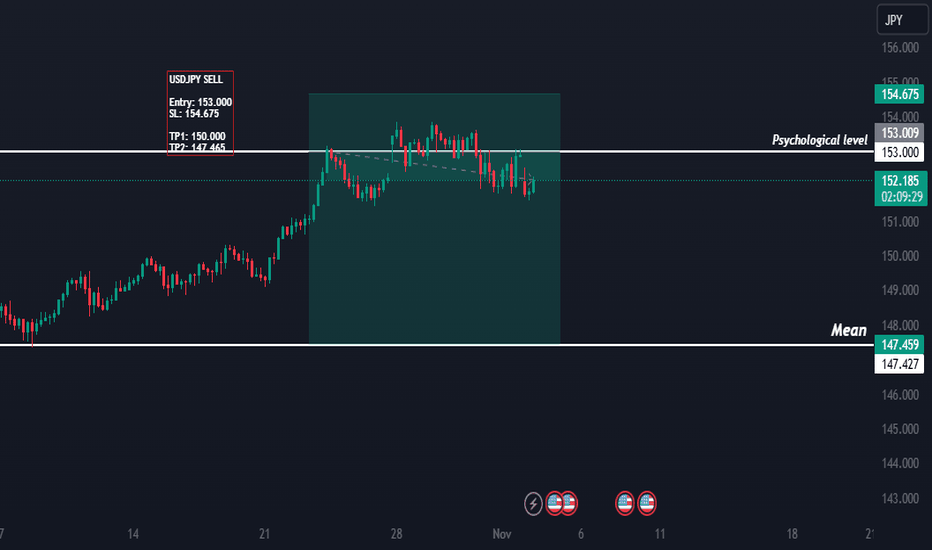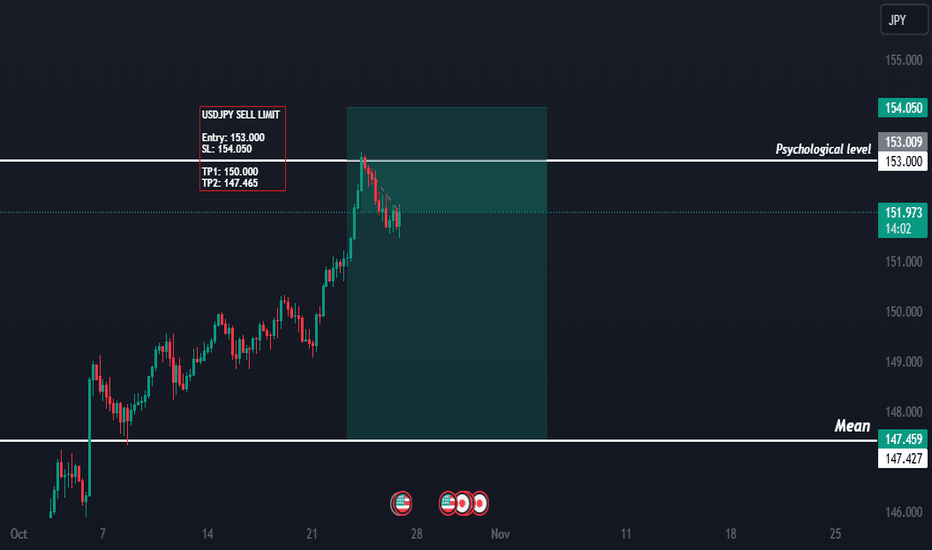USDJPY Analysis: Anticipating a Slight Bearish Bias on November USDJPY Analysis: Anticipating a Slight Bearish Bias on November 4, 2024
Introduction
On November 4, 2024, the USDJPY (US Dollar to Japanese Yen) currency pair is showing signs of a potential slight bearish bias. A mix of fundamental factors, including recent economic data from the United States and Japan, is influencing the current outlook for USDJPY. In this article, we’ll analyze the latest drivers and market conditions impacting USDJPY today to help traders make informed decisions. To ensure visibility on TradingView and search engines, we’ve included essential keywords for better SEO optimization.
Key Drivers Impacting USDJPY Today
1. US Dollar Weakness Following Economic Data
- The US dollar has shown signs of weakening after recent economic reports painted a mixed picture of the US economy. Non-farm payroll data released last week fell short of expectations, suggesting a slowdown in job growth. Additionally, the latest PMI (Purchasing Managers' Index) data came in weaker than forecasted, hinting at a potential softening in the manufacturing sector. This weaker data weighs on the USD, allowing for a possible downside in USDJPY.
2. Bank of Japan’s Stable Policy and Economic Outlook
- The Bank of Japan (BoJ) has maintained a steady approach to monetary policy, signaling no immediate changes. With inflation remaining below target, the BoJ has resisted pressures to tighten rates aggressively. However, Japan’s economy has recently shown slight signs of improvement, with better-than-expected GDP and consumer spending data. This stability may lend some support to the Japanese yen, creating downward pressure on USDJPY.
3. Interest Rate Expectations
- Interest rate differentials remain a significant factor for USDJPY. While the Federal Reserve recently suggested that it will maintain interest rates in the near term, markets are beginning to price in potential rate cuts in 2024 due to softening US economic data. This shift in sentiment could favor the Japanese yen over the US dollar, as investors seek safe-haven assets like the yen amid concerns over slower US growth.
4. Geopolitical Factors and Safe-Haven Demand
- Recent geopolitical developments have increased demand for safe-haven assets, with the Japanese yen benefiting as a result. Investors tend to turn to the yen in times of uncertainty, and with global tensions on the rise, the yen may see an uptick in demand. This safe-haven appeal could contribute to a bearish outlook for USDJPY as investors look to reduce exposure to the USD.
5. Technical Analysis and Key Levels
- Technically, USDJPY shows signs of potential downside pressure. The currency pair is approaching a support level near 147.50, with resistance around 149.00. The Relative Strength Index (RSI) indicates a near-neutral level but is trending downward, signaling possible bearish momentum. Should USDJPY break below the 147.50 support, it could pave the way for further declines.
Conclusion
Given the above factors, USDJPY is likely to experience a slight bearish bias today. The combination of weaker US economic data, stable policies from the Bank of Japan, changing interest rate expectations, and rising safe-haven demand supports a bearish outlook. As always, it’s essential to keep a close watch on any new economic releases or geopolitical developments that could influence USDJPY in the coming hours.
Stay tuned to TradingView for real-time updates and in-depth USDJPY analysis.
---
SEO Keywords for USDJPY Article
SEO-KEYWORDS:
#USDJPYforecast
#USDollartoJapaneseYen
#USDJPYanalysis
#ForextradingUSDJPY
#USDJPYbearishtrend
#USDJPYtodaysoutlook
#BankofJapanpolicyimpact
#USDollarweakness
#Safehavencurrency
Usdjpybearishtrend
USDJPY Bearish Bias on October 29, 2024: Fundamental Analysis !USDJPY Bearish Bias on October 29, 2024: Fundamental Analysis and Key Market Drivers
Overview: USDJPY Daily Analysis with Slight Bearish Bias on 29/10/2024
As of October 29, 2024, the USDJPY (U.S. Dollar to Japanese Yen) currency pair leans toward a bearish bias, driven by a range of economic factors and shifting market sentiment. The Japanese Yen, often considered a safe-haven currency, appears set for gains as investor risk appetite remains cautious. In this analysis, we’ll break down the primary drivers of a bearish USDJPY outlook and explore what this could mean for traders today.
Key Drivers for USDJPY Bearish Bias
1. Dovish Stance from the Federal Reserve
- The U.S. Federal Reserve's recent statements have indicated a more dovish tone, with Chair Jerome Powell suggesting a pause in rate hikes as the U.S. economy faces slower growth and moderating inflation.
- As the Fed scales back aggressive tightening, demand for the USD could soften, giving way to downward pressure on USDJPY.
2. Economic Resilience in Japan
- Japan’s latest economic indicators, including rising exports and steady growth in industrial output, are showing signs of resilience. The Bank of Japan (BOJ) has maintained its accommodative policies, yet recent remarks hint at a more balanced approach, adding stability to the JPY.
- With the Japanese economy performing well, the Yen is gaining support, especially against a potentially weaker USD.
3. Risk-Off Sentiment in Global Markets
- USDJPY typically reacts to shifts in risk sentiment, as the Yen benefits from safe-haven flows. In today’s market, concerns over geopolitical risks and potential global economic slowdown are driving investors to seek safer assets.
- This risk-off environment is reducing demand for USD-denominated assets while increasing interest in JPY, putting additional bearish pressure on USDJPY.
4. U.S. Dollar Weakness Amidst Lower Treasury Yields
- U.S. Treasury yields have pulled back as the Fed pauses its rate hikes. Lower yields tend to weaken the appeal of the USD compared to safe-haven currencies like the Yen.
- This yield differential further supports a bearish USDJPY outlook, as lower Treasury returns make the USD less attractive in the FX market.
Technical Analysis of USDJPY
On the technical front, USDJPY is approaching a support zone near 148.00, with resistance around the 149.80 level. If the bearish bias continues and the pair falls below this support, we could see USDJPY trend lower, making this an important level to watch.
Conclusion: USDJPY Outlook on October 29, 2024
Today’s fundamental and market conditions suggest a bearish bias for USDJPY. A dovish Fed, Japan’s economic resilience, cautious market sentiment, and lower U.S. Treasury yields are all factors likely to favor the Yen over the Dollar. Traders should monitor key support levels and any shifts in risk sentiment, as these could impact USDJPY’s trend throughout the day.
---
Tags:
USDJPY analysis, USDJPY forecast, Japanese Yen outlook, Forex market trends, USDJPY bearish trend, Federal Reserve impact on USD, USDJPY technical levels, Forex trading insights, October 2024 USDJPY
USDJPY: Potential for a Slight Bearish Bias Amid Key FundamentalUSDJPY: Potential for a Slight Bearish Bias Amid Key Fundamental Drivers (25/10/2024)
Today, the USDJPY currency pair could experience a slight bearish bias, driven by recent shifts in both the Japanese and U.S. economic landscape. Here’s a breakdown of the factors contributing to this potential trend, along with insights into what traders should watch as the day unfolds.
1. Bank of Japan’s Potential Shift in Policy
The Bank of Japan (BoJ) has maintained its ultra-loose monetary policy stance for years, but recent signals suggest a possible move towards tightening. Japanese inflation rates have gradually risen, and with core inflation holding steady above target levels, the BoJ may finally consider adjusting its dovish stance. Any indication of a shift toward a more hawkish BoJ, even if gradual, could support the JPY, creating downward pressure on the USDJPY pair.
2. US Dollar Weakness on Federal Reserve Pause Speculation
The US Dollar (USD) has softened recently as speculation grows that the Federal Reserve may pause rate hikes. U.S. economic data has shown signs of cooling inflation, and Fed officials have hinted that a pause could be on the horizon, given recent macroeconomic indicators. A dovish tone from the Fed typically weakens the USD, thus enhancing the relative strength of the JPY. This potential softening in the dollar is an essential factor in the slight bearish bias for USDJPY.
3. Market Sentiment Shifting Towards Safe-Haven Assets
Investor sentiment is currently tilted toward safe-haven assets, largely due to ongoing geopolitical tensions and uncertain global economic conditions. While the USD is also a safe-haven currency, the Japanese Yen (JPY) often gains favor when there’s heightened uncertainty in markets, especially in Asia. This risk-averse sentiment is driving investors to seek the JPY, which could contribute to additional downward momentum in the USDJPY pair today.
4. Technical Indicators Suggest Resistance for USDJPY
From a technical perspective, USDJPY is encountering resistance around the 150.00 level. This is a critical psychological threshold, and the pair’s failure to break above this level reinforces a potential bearish sentiment. With Relative Strength Index (RSI) levels approaching overbought territory, a bearish correction might be anticipated. Additionally, a dip below the 149.00 support level could confirm this outlook and signal further downside potential.
Summary: Slight Bearish Bias for USDJPY
Today’s fundamental factors suggest a slight bearish bias for USDJPY, largely due to potential changes in Bank of Japan policy, a softer US Dollar from Federal Reserve pause speculation, and increased demand for safe-haven assets. Technical resistance at key levels also reinforces the likelihood of a bearish tilt for the pair.
Traders should watch for real-time updates on BoJ announcements, Fed commentary, and any developments in geopolitical news that could impact USDJPY direction.
---
Keywords
1. USDJPY forecast
2. Bank of Japan policy
3. US Dollar analysis
4. Fed rate pause
5. USDJPY bearish trend
6. Forex trading insights
7. Safe-haven assets
8. Japanese Yen strength
9. USDJPY technical levels


